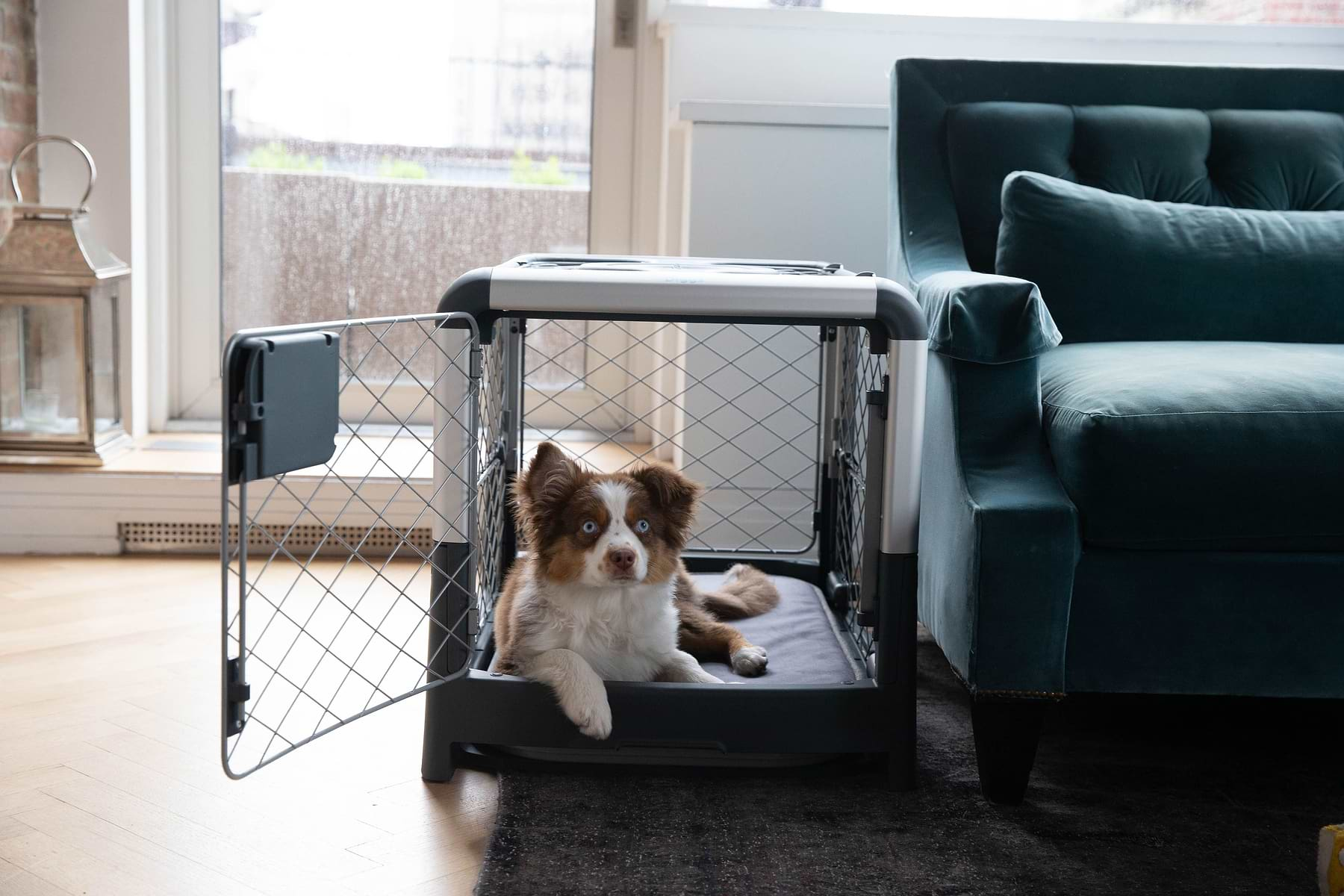The majority of dogs learn how to pee outdoors pretty quickly. Just like us, dogs don’t like to wet the bed! But from time to time, accidents happen, and some dogs may frequently pee in their crates for one or more reasons.
Today, let’s explore why your dog may be peeing in their crate and break down some strategies you can use to stop the habit for good.
Why Do Dogs Pee in Their Crates?
As a rule, dogs don’t like to urinate in the same place they sleep. It’s unhygienic and it can make them feel bad about themselves. However, dogs (and especially young puppies) may still occasionally pee in their crates, especially during the earliest weeks and months of crate training.
Why? In truth, your dog may be peeing in their crate for several reasons.
Their Routine Is Messed Up or Not Set Yet
If your dog is a young puppy, they might be peeing in their crate just because they aren’t yet used to a solid routine. For example, if you have just started house or crate training your dog, they may decide that it’s not really their sleeping area yet and will urinate when they have to go.
Similarly, a dog could pee in their crate if the daily routine is messed up in some way. Dogs generally love daily routines, especially since it tells them when they can expect to go to the bathroom. If the routine is messed up, such as by you forgetting to take them on a walk, they could pee in their crate out of necessity.
Bladder Control Issues
In some cases, your puppy might just have bladder control problems and you are leaving them in their crate for too long. Generally, puppies can hold their urine for one hour for each month of their age. For example, if your puppy is two months old, you should only expect them to be able to hold their bladders for two hours maximum.
Adult dogs can eventually hold their pee for up to 10 hours or so, but that doesn’t necessarily mean they should have to. You should let adult dogs out to take care of business at least three to five times per day.
If your dog is still very young, your puppy might just pee in their crate because they can’t hold their bladder for as long as you expect. Pee accidents are more common at night when you and your puppy might be sleeping for longer stretches of time, but your puppy may still wake up to urinate if they can’t hold it.
Behavioral Problems
Although dogs don’t normally pee out of spite or anger, your dog might still have behavioral issues causing them to do their business in their crate.
The most common reason for this is separation anxiety. Dogs who have become used to the constant presence of their pet parents may urinate as a fearful reaction when they leave or are out of sight. This may be more common if the dog is left in their crate at home alone while the parent goes to work.
Separation anxiety and other behavioral problems are often grown out of, but they can also be trained away with positive reinforcement and encouragement. Professional pet training may also assist if your dog resists other behavioral fixes.
Medical Problems
Lastly, some dogs may pee in their crates because of medical issues. For example, if your dog has a bladder infection, their ability to hold their urine could be compromised and they may pee more frequently as a result.
If you think your dog is having a medical issue that makes them pee in their crate, contact a veterinarian right away. Odds are they’ll be able to solve the issue with targeted medication or therapy and things will be back to normal in a few days or weeks.
How to Stop Your Dog from Peeing in Their Crate
Once you’ve narrowed down the likely issue causing your dog to pee in their crate, you can start working on solutions. There are four big things you can do to alleviate the majority of crate-peeing incidents.
Use a Pee Pad
First, consider installing a pee pad in your dog’s crate. This tip is best for puppies who may have difficulty controlling their bladder in the earliest months of life.
If you don’t want to take your dog out in the middle of the night, a pee pad gives your pup the opportunity to pee somewhere that isn’t their bed. They can do their business in half of the crate, then go to the clean half of the crate to go back to sleep.
At this early age, your dog is likely small enough that everything can fit in the crate until morning. Once your puppy is old enough, you can remove the pee pad and they should be able to hold their bladder until morning.
This may also be good for older dogs who are experiencing incontinence or other issues, especially in the middle of the night. However, be sure that your dog can comfortably fit in the dog crate with the pee pad before relying on the solution long-term.
Exercise Your Dog
Going on a morning walk with your dog is a good rule of thumb for lots of reasons. It gives you and your pup some fresh air, exercises your dog and gives them a chance to stretch their legs, and gives them an opportunity to go to the bathroom.
Exercising your dog is great since it doesn’t put a lot of pressure on your pup to pee immediately. If you only take your dog outside to urinate, then bring them right back in, they might try to hold their bladder so they get to spend more time smelling interesting things outdoors.
Take your dog on a quick walk at a minimum. They should go to the bathroom and start trusting that they’ll have the opportunity to do so at their own pace. With time, they may stop peeing in their crate as a result.
Set a Strict Daily Routine
As noted earlier, dogs love routines. The best way to get your dog to stop peeing in their crate is to give them a routine they can count on.
For example, if you always take your dog out at certain times of the day to go to the bathroom, they will gladly hold their bladder and wait for the right opportunity to pee. They won’t go in their crate since they trust that you’ll be home in time to take them outside before things reach an emergency level!
Visit a Vet
If your dog has any medical issues, the only real solution is to visit a vet. Say that your dog has a bladder infection. In that case, your veterinarian will have to prescribe your dog antibiotics or other dog medications to take care of the problem.
Furthermore, a vet can investigate your dog’s bladder and other systems to check for other problems. If your dog has a bladder infection or you suspect their crate peeing problem is because of medical stuff, you can’t handle it alone. Don’t try to fix it through special routines or home remedies.
Summary
Ultimately, your dog might be peeing in their crate for several reasons. But the good news is you can always help your dog overcome this issue and sleep comfortably in their dog bed with a few strategies and fixes. Being a good pet parent means helping your dog overcome issues like these, so you’re already on the right path by trying to figure out what’s wrong.
What if you need a new crate for your dog, either because they are growing bigger or because you want to give them a new, comfortable home where they haven’t made a mess? The Diggs Revol Crate could be just what you need, featuring a safe yet sturdy design, collapsibility, and a puppy divider that comes with the purchase. In short, it’s everything you need to crate train your new canine companion.
Check out the Diggs Revol Crate and our other pet parent solutions at our online store today!
Sources:
Urinary Incontinence (Urethral Incontinence) in Dogs | VCA Animal Hospital

The Diggs Team
We believe our dogs deserve safer, better designed pet products.
You might also like
Crate training tips, stories and inspiration
View all blogsIn Your Diggs
Share your photos with #DiggsPet and tag us @DiggsPet on IG and TikTok.



